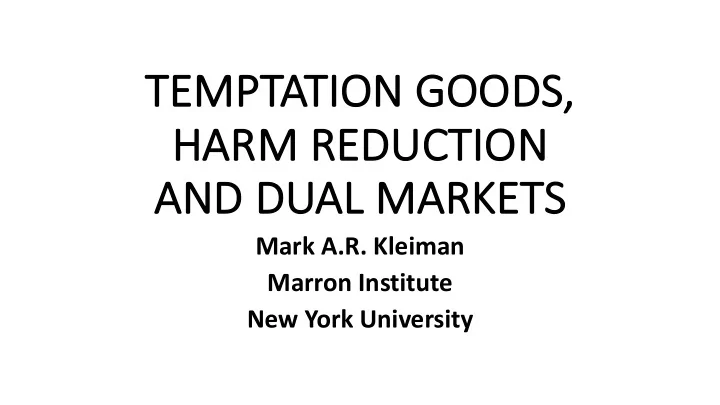

TE TEMPTATI TION GOODS, HARM REDUCTI TION AN AND DUAL AL MAR ARKETS Mark A.R. Kleiman Marron Institute New York University
Te Temptation goods: no ordinary commodities Tendency to induce excessive consumption compared to the user’s own long-term desires or goals “Continued use despite known adverse consequences” Time-inconsistent behavior Self-strategy (Schelling)
Te Temptation goods: examples • Alcohol • Nicotine • Cannabis • Opiates • Stimulants • Gambling • Sweet/salty/oily foods • Videogames • Pornography
Te Temptation goods create “internalities” Axioms of consumer choice fail to hold Paternalistic intervention may be warranted. - Taxation - Regulation - Prohibition Those interventions always create adverse effects, including the risk of illicit markets
No good is a temptation good for all consumers * Typical case: minority of problem users, majority of contented users * Pareto’s Law: 80% of the activity concentrated in 20% of the users * Likely to overlap heavily with problem users *Certain to dominate the economics of the market, licit or illicit
Th The “harm reduction” controversy Tension between policies designed to reduce extent of use and policies designed to make use less harmful Harm reduction is three things - A utilitarian maxim - A set of techniques - An ideology
Ma MacCou Coun’s Eq Equation H H = h x u H = total harm h = harmfulness or harm rate u = extent of use Reducing h or u reduces H as long as the other factor doesn’t increase more than proportionally.
Th The nicotine harm reduction controversy Should less-harmful forms of nicotine be encouraged to reduce harmfulness or discouraged to prevent an increase in use? Either is a “public health” approach. The (rational) difference concerns harm ratios among products and theories of consumer behavior
Recommend
More recommend